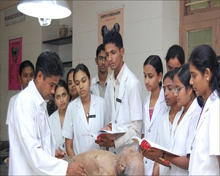Shortage of Medical Professionals in India
Shortage of Doctors in India
 In order to cope up with the surging demand for healthcare
facilities in urban and rural areas, India will have to add 36
lakh new beds, 30 lakh doctors and 60 lakh nurses over the next
20 years, according to a study by the consultants
Pricewaterhouse Coopers (PwC).
In order to cope up with the surging demand for healthcare
facilities in urban and rural areas, India will have to add 36
lakh new beds, 30 lakh doctors and 60 lakh nurses over the next
20 years, according to a study by the consultants
Pricewaterhouse Coopers (PwC).
Nearly one lakh hospital beds are being added per annum in the last decade and if this rate is being maintained, then the country would fall short of the target by 16 lakh beds in 2034.
 At present, the number of doctors and paramedics are much below
the desired level thus proving to be a great handicap for
extending healthcare to vast sections of people who are left out
of even basic medical services like reproductive care,
vaccination, fever diagnosis and simple health check-ups.
At present, the number of doctors and paramedics are much below
the desired level thus proving to be a great handicap for
extending healthcare to vast sections of people who are left out
of even basic medical services like reproductive care,
vaccination, fever diagnosis and simple health check-ups.
There are only 0.65 doctors, 1.3 nurses and 1.3 hospital beds per 1,000 people in the country. The PwC study points to an investment need of $245 billion if the desired levels of 2.5 doctors, 5 nurses and 3.5 beds per 1,000 people have to be achieved by 2034.
How India Can Overcome the Doctor Shortage
Experts in the healthcare field have called for adopting
low-cost operational models along with innovative funding to set
up the required facilities in remote areas of the country.

For this to be successful, efforts through the public-private partnerships have to be made which can set up low-cost speciality clinics like Arvind eye hospital in Madurai and heart care specialist Narayana Hrudayalaya in Bengaluru.
The existing hospitals must utilise their assets to their full capacity and nurses have to be trained to perform some tasks usually done by doctors (para skilling) which can further lower the cost of healthcare delivery and further enable the staff to service a large volume of patients.
India must fully take advantage of its leadership in IT sector and top position in vaccine production to reach out to rural populace with efficient diagnostic care and curative treatment. According to the PwC study, the use of digital tools and capabilities in vaccine generation will enable the country to save $90 billion in capital expenditure.
 Leveraging digital technologies and strength as a world leader
in vaccine manufacturing also can help the country save about
$90 billion in capital costs, says the study.
Leveraging digital technologies and strength as a world leader
in vaccine manufacturing also can help the country save about
$90 billion in capital costs, says the study.
Apart from channelising the capital flows from the private investors, the government has to be proactive in making conditions favourable for talented doctors and paramedical staff to practice medicine in rural areas where nearly 75% of our population live bereft of even minimalist services in healthcare.
Articles on Health
- Laparoscopic Surgery Advantages
- Laparoscopic Surgery History
- Laparoscopic surgery Procedures
- Limitations of traditional laparoscopic surgery
- New technologies for advance laparoscopic surgery
- Non-Robotic Laparoscopic Surgery
- Robotic Laparoscopic Surgery
- Causes and remedy for dark circles in females

- Harmful impact of mobile phone on unborn baby

- Maternal health care tips

- Rheumatoid Arthritis is Most Widespread in Female
- Periodontal ailment during Pregnancy
- Anemia is prevalent in Women
- Effect of Cell phone tower radiation on human health

- Current health scenario india
- Government health policies india
- Medical facilities india
- Hospital infrastructure india
- Shortage of Medical Professionals in India
- Quality standards indian hospitals
- Indian states health statistics
- Medical expenses india
- Hospitals in Ahmedabad
- Hospitals in Bangalore
- Hospitals in Chennai
- Hospitals in Cochin
- Hospitals in Delhi
- Hospitals in Hyderabad
- Hospitals in Kolkata
- Hospitals in Mumbai
- Hospitals in Pune
- Hospitals in Coimbatore
- Hospitals in Kochi
- Orthopaedics Hospitals in India
- Diabetology Hospitals in India
- Cardiology Hospitals in India
- Infertility Hospitals in India
- Neurology Hospitals in India
- Paediatrics Hospitals in India
- Nephrology Hospitals in India
- Oncology Hospitals in India
- Antiaging foods to improve skin

- Tips for Maintaining healthy bones
- Guidelines for preventing heart disease
- Tips to reduce eye strain while working on computer
- Mental health problems among elderly people
- Health problem of piles

- Health advices for air travel

- Dealing with Allergies
- Tips for Eyes Care
- Care for Crystal Clear Skin
- Tips For Healthy Hair
- Healthy Living is The Absolute Measure of Happiness
- Let Fragrance Rule Your Summer
- Most common vestibular disorder

- Osteoporosis Risk Factors
- Dengue

- Endocrine disorder

- Causes of liver damage
- Dry eye syndrome
- Kidney Stones
- Conjunctivitis: Irritating eye disease
- Anxiety Disorder
- Causes of Brain Damage
- Hepititis B
- Knowledge of Osteoarthritis
- Mental Illness
- Back Pain
- Sugar Addiction
- Diet Control Plans
- General Motors Diet Plan
- No Carbohydrate Diet
- One day Diet Plans
- Seven day diet Plans
- Vegetarian Diet
- Food for Health
- Genetically Modified Foods
- Healing Effects Of Fruits
- Vegetables That Heal
- Healing Effects Of Spices and Herbs
- Test your Stress Level
- Mantras for Relaxation & Stress free life
- Take walk For a healthy body and mind
- Squint is frequently observed in Children
- Consult-Doctor
- Free Handy Health Advice